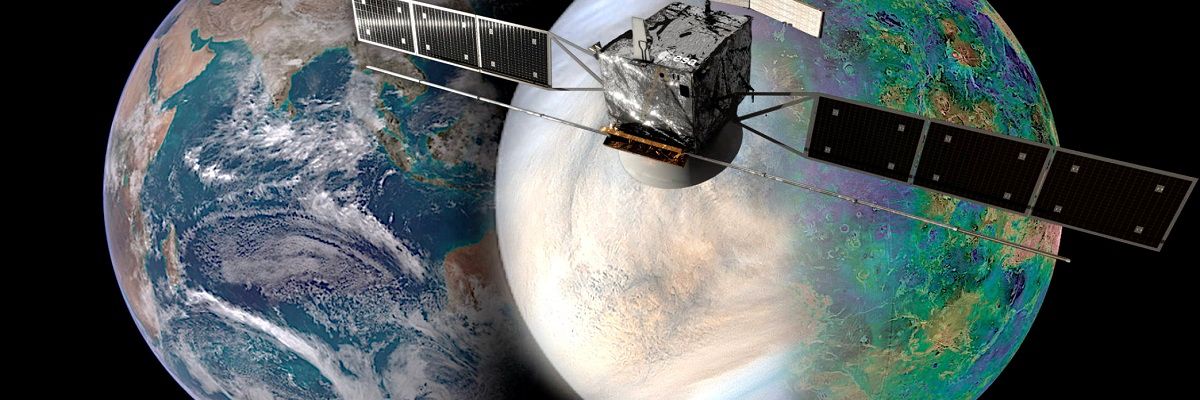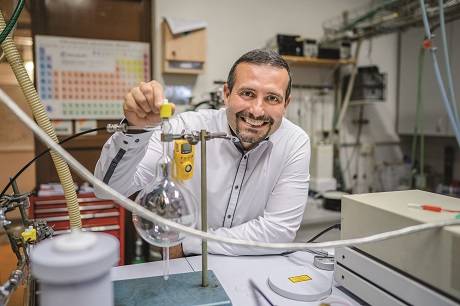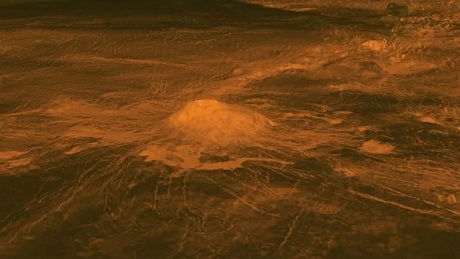
Czechs part of mission set to explore why Venus and Earth evolved differently
17. 01. 2024
It may be Earth’s similarly sized neighbour, but not even the toughest organism on our planet could survive there. Venus is sometimes called Earth’s infernal twin. Its atmosphere is mostly made up of carbon dioxide and its average surface temperature is over 460 degrees Celsius. And yet, once upon a time, Venus apparently had oceans full of water. What happened? Why is present-day Venus a hellscape? Was there ever life on Venus, and can there still be? The ESA-led EnVision mission, scheduled to launch in 2031, may provide some clues. Researchers from the J. Heyrovský Institute of Physical Chemistry of the CAS, the Institute of Geophysics of the CAS, and the Czech Geological Survey, as well as a number of Czech companies, are working on the preparation of the EnVision space probe.
The involvement of Czech partners in the project led by the European Space Agency was certainly not a given and was preceded by long and demanding preparations. “I feel as if my colleagues and I have just crossed the finish line of the marathon and the joy is slowly but surely sinking in. For the Czech Republic, a space project of this type and scale is an incredible success,” says Martin Ferus from the J. Heyrovský Institute of Physical Chemistry of the CAS, who is leading the Czech team.
The Czech heart of the spectrometer
The task of the Czech team is to design, construct, and test the electronic “heart” of the VenSpec-H advanced spectrometer – the central processor, the mechanical control unit, and the data processing system. “The electronic components will be designed by engineers who are experts in space technology. On our part, as physical chemists, we are in charge of the scientific and technical aspects of the project, which include the simulation of data packets, testing their functionality in data processing, compliance with the functionality of the spectrometric device as a whole as well as managing and representing the Czech Republic in the international satellite consortium,” Ferus explains.

Martin Ferus, the scientific representative for the Czech Republic for the EnVision mission and principal investigator of the project.
His home institute, the J. Heyrovský Institute of Physical Chemistry of the CAS, has a legacy to build on. In the past, researchers there have been actively involved in the preparation of ESA’s Ariel space mission, scheduled for launch in 2029, and are also working on other space missions and instruments of their own. For example, they are building a spectrometer for observing meteors from orbit or a small-scale mass spectrometer for chemical analysis aboard drones, satellites, landers, moonwalkers, and Mars rovers. “All this has served us as a stepping stone to get involved in space missions like EnVision,” Ferus says.
Venus, a “cosmic Rorschach test”
That Venus is habitable was still a common perception at the beginning of the last century. However, in the 1930s, spectroscopic observations hinted at the planet being plagued by very high temperatures due to an ongoing massive greenhouse effect. This hypothesis was confirmed three decades later by satellite measurements.
In the course of space exploration, the surface of Venus has been mapped with the use of radar images. Only a few space probes have managed to land directly on the planet, and their lifespan has been limited by their inability to cool their landers effectively in extremely high temperatures.

Appearances can be deceptive. A toxic atmosphere lies beneath the dense cloud cover, full of carbon dioxide.
The first European space probe was sent to Venus in 2005. Until 2014, Venus Express mainly focused on exploring the planet’s atmosphere, but it also produced groundbreaking news about possible volcanic activity on the planet. EnVision will explore Venus in coordination with the upcoming US NASA missions, DAVINCI+ and VERITAS. The trio of space probes could provide the most comprehensive and holistic picture of Venus to date.
Life on Venus?
“What I’m really looking forward to is detecting the atmospheric gas concentration profiles of carbonyl sulphide, carbon monoxide, sulphur dioxide, and hydrogen chloride. Knowing the exact concentration of these chemical compounds in the atmosphere in relation to height above the surface can tell us how the processes work on the dust particles we study in our lab,” Ferus reveals. “This is a completely new chemistry that results in the spontaneous breakdown of molecules on dust particles into chemicals whose presence in the atmosphere of Venus have been widely debated,” he adds.
For ages, humankind has wondered whether it is alone in the universe or if there is anything “out there”. So, could there be life on infernally hot Venus? “Based on our experimental and theoretical results, I have reason to believe that there is no life on Venus and that the presence of certain chemicals is due to the chemistry we have observed on the dust particles, which is even capable of mimicking the biochemical processes of photosynthesis of organic matter! All while being purely abiotic, albeit very complex chemistry on mineral surfaces,” Ferus says.
Volcanic Venus?
Making use of the instruments aboard EnVision, we could also learn details about the geological and geophysical conditions on Venus, such as its possible volcanic activity. Petr Brož from the Institute of Geophysics of the CAS, whose long-term research focuses on volcanism on other planets in the Solar System, is involved with the project. “Personally, I am most looking forward to finding out if there really are active volcanoes on Venus and, if so, how the volcanic eruptions occur. After all, volcanic activity under conditions of a pressure of ninety atmospheres will have to look different in many aspects from what we are used to on Earth,” he says.

The summit of Idunn Mons volcano on Venus. Image based on data obtained from NASA's Magellan spacecraft.
“It will also be interesting to find out which gases the volcanic activity might be ejecting into the atmosphere. This would allow us to better understand why Venus has gone the way of a planet that has not ‘managed’ its greenhouse gases well. From the research of Venus, we could actually learn a lot about the past and future evolution of the Earth,” Brož adds, whose primary role in the EnVision mission is being the liaison officer between the international scientific team and the Czech design team.
A small country with space capabilities
The production of the components in the Czech Republic will be funded by the European Space Agency as part of the “Czech participation in the EnVision mission – the derisking of VenSpec-H development” project that falls under the PROgramme de Développement d’EXpériences scientifiques (PRODEX). The project is led by researchers and developers from the Royal Belgian Institute for Space Aeronomy. “Our colleagues from Belgium were enthused by the level of expertise of the space engineers in our team. The overall impression of the meeting was very positive on both sides,” Ferus notes.
According to Ferus, the Czech involvement in the project would not have been possible without the help of the Czech representation in the European Space Agency. It is thanks to our participation in the agency that the space industry in the Czech Republic is steadily growing and has the potential to remove the unwelcome label of assembly plant from our country in the future. “We can show that we have at our disposal highly-qualified experts and enthusiasts and that we have the ability to make cutting-edge technologies with high added value,” Ferus points out. And every future project similar to EnVision has the potential to bring us closer to the coveted position of a small country with groundbreaking capabilities in space research and technology.
Prepared by: Leona Matušková, External Relations Division, CAO of the CAS, drawing on the press release of the CAS
Translated by: Tereza Novická, External Relations Division, CAO of the CAS
Photo: NASA/JPL-Caltech/ESA and archive of the J. Heyrovský Institute of Physical Chemistry of the CAS The text is released for use under the Creative Commons license.
The text is released for use under the Creative Commons license.
Read also
- A trapped state: The pandemic impact on public attitudes, trust, and behavior
- Aerial archaeology: Tracing the footsteps of our ancestors from the sky
- Archaeologists uncover ancient finds along Prague Ring Road
- Our microbiome largely depends on what we eat, says microbiologist Michal Kraus
- The ABCs of writing: Why did its invention mark a turning point for humankind?
- We learn, remember, forget… What can memory actually do? And can we outsmart it?
- New Center for Electron Microscopy in Brno opens its doors to global science
- The hidden lives of waste: What can we learn from waste workers and pickers?
- A unique lab is hidden right beneath Prague’s Vítkov Hill
- Renewables are a strategic investment in European security, scientists say
The Czech Academy of Sciences (the CAS)
The mission of the CAS
The primary mission of the CAS is to conduct research in a broad spectrum of natural, technical and social sciences as well as humanities. This research aims to advance progress of scientific knowledge at the international level, considering, however, the specific needs of the Czech society and the national culture.
President of the CAS
Prof. Eva Zažímalová has started her second term of office in May 2021. She is a respected scientist, and a Professor of Plant Anatomy and Physiology.
She is also a part of GCSA of the EU.